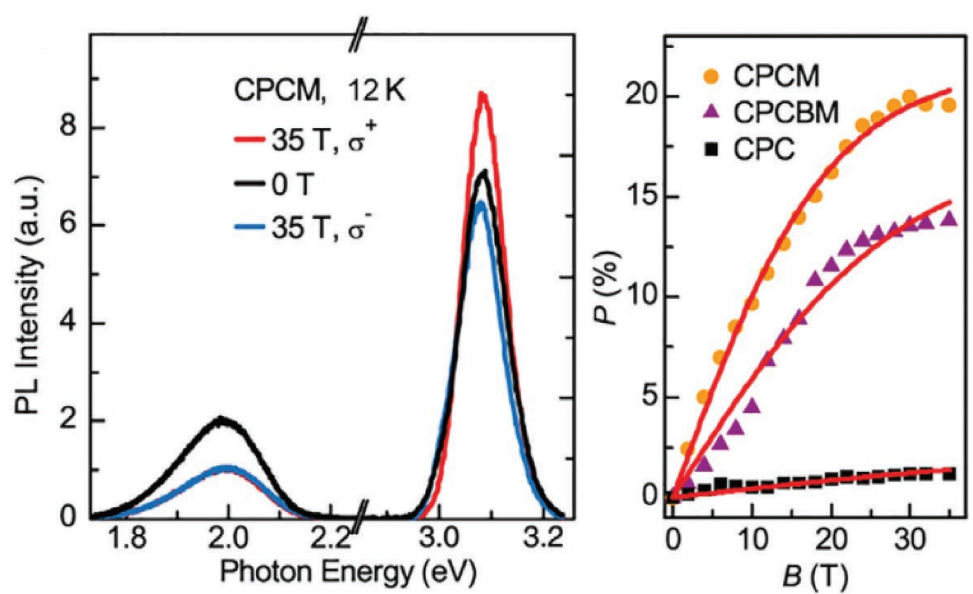
a. Electronic orbital arrangement in CsPb(Cl/Br)3:Mn perovskite, b. Magneto-photoluminescence measurement setup and c. circular polarized PL results (DPL = left hand circular PL – right hand circular PL), d. Degree of circular polarization.
Background
Magnetic field enhanced spin polarized electronic/optical properties in semiconductors are crucial for fabrication of various spintronic devices. However, this spin polarization is governed by weak spin exchange interactions and easily randomized by thermal fluctuation, therefore it was only produced at cryogenic temperatures, which severely limits their applications. This MFE was initially found to enhance the circular polarization of light emission in GaMnAs thin films: about 43% at the magnetic field of 7 T and temperature of 2 K. Later, ZnSe/CdS:Mn quantum dot was found to exhibit stronger MFE: with nearly 100% circular polarization at 6 T and 1.8 K. Semiconductors with room temperature intrinsic magnetic field effect are extremely desirable for advancing the spintronic applications. However, no such material has been reported to date.
What we discover?
We report, for the first time, a room temperature intrinsic magnetic field effect (MFE) on the excitonic photoluminescence (PL) is achieved in CsPbX3:Mn (X = Cl, Br) perovskite nanocrystals. Through moderate Mn doping, the MFE is enhanced by exciton-Mn interaction, and through partial Br substitution, the MFE is stabilized at room temperature by exciton orbital ordering. The orbital ordering significantly enhances theg-factor difference between electron and hole, which is evidenced by a parallel orbit-orbit interaction amongexcitons generated by circular polarized laser excitation.
Why is this important?
Achieving room temperature intrinsic MFE is valuable for making fast spin-photonic devices such as spin light-emitting diode based on the short PL decay and spin relaxation times in perovskites, compared to that in organic semiconductors. Furthermore, the realization of enhanced spin polarization by orbital ordering fundamentally opens up new ways for designing and fabrication of room temperature spintronic device.
Why did we need WHMFC?
For excitons in semiconductor,when the magnetic field is strong enough, the Zeeman energy becomes comparable to the exchange energy between electron and hole, andthe difference between spin-up and spin-down electrons’ population would be enlarged by increasing magnetic fields, which would give rise to the field induced circular polarization (FICPO) in the optical transitions and the resultant PL.

The saturation of circular polarization could only be observed at very high magnetic field when the Zeeman energy exceeds the exchange energy.
Who did the research?
1.Wuhan National High Magnetic Field Center and School of Physics, Huazhong University of Science and Technology, Wuhan P. R. China
Dr. K. Zhang, J. Zhao, Y. Zhang, R. Huang, Y. Ma, Prof. Z. Wang, Prof. Z. Ouyang, Prof. J. Han, Prof. Y. Han*
(Corresponding author:Yibo Han, ybhan@hust.edu.cn)
2.Wuhan National Laboratory of Optoelectronics, Huazhong University of Science and Technology, Wuhan China
Dr. Q. Hu, Prof. J. Tang
3.State Key Laboratory of Materials Processing and Die & Mould Technology, School of Materials Science and Engineering, Huazhong University of Science and Technology, Wuhan China
Dr. S. Yang, Prof. T. Zhai*
(Corresponding author: Tianyou Zhai, zhaity@hust.edu.cn)
4.Department of Materials Science and Engineering, University of Tennessee, Knoxville, USA
Dr. X. Zhu
5.Anhui Province Key Laboratory of Condensed Matter Physics at Extreme Conditions, High Magnetic Field Laboratory of the Chinese Academy of Science, Hefei China
Dr. W. Tong, Dr. L. Zhang
Acknowledgments
We are grateful for fruitful discussions with Prof. Bin Hu from Univ. TN, Prof. Xuefei Li, Prof. Junfeng Wang, and Prof Zengwei Zhu from WHMFC.This study was supported by the Natural Science Foundation of China (Grant No. 11974126, 11104097 and 21825103) and the National Key R&D Program of China (Grant No.2016YFA0401704).
Link
https://onlinelibrary.wiley.com/doi/10.1002/adma.202008225
